-
Paper Information
- Paper Submission
-
Journal Information
- About This Journal
- Editorial Board
- Current Issue
- Archive
- Author Guidelines
- Contact Us
Architecture Research
p-ISSN: 2168-507X e-ISSN: 2168-5088
2018; 8(4): 129-137
doi:10.5923/j.arch.20180804.03

Evaluation of the Impact of Sustainability Principles on Adaptive Reuse Interventions: The Case of Qatari Heritage Experience
Silvia Mazzetto
Department of Architecture and Interior Design, School of Architecture and Design, Lebanese American University, Beirut, Lebanon
Correspondence to: Silvia Mazzetto, Department of Architecture and Interior Design, School of Architecture and Design, Lebanese American University, Beirut, Lebanon.
| Email: |  |
Copyright © 2018 The Author(s). Published by Scientific & Academic Publishing.
This work is licensed under the Creative Commons Attribution International License (CC BY).
http://creativecommons.org/licenses/by/4.0/

In recent years, due to the oil discovery and exportation, Qatar a small country in the Persian Gulf has typically experienced accelerated and complicated problems of urbanization. Affecting the direction of the rapid urbanization, there is a perpetual dispute, between the construction of new, modern identity and the promotion of traditional architecture as a possible way to establish new relations with the local history and culture. The paper presents some significant examples of adaptive reuse projects, recently completed in Qatar, and shows the increasing demand to strengthen recognition of the local architecture and regenerate the consciousness of the national heritage values. The interventions have been analyzed and compared concerning environmental, socio-economic and socio-cultural aspects derived from the adaptive re-use projects. Sustainability, as a cultural, social, environmental, and energy-saving value, is one of the most distinguished principles that should be applied to the whole process of heritage restoration. The results show that there exist many common points between the re-use of Qatari heritage, the conservation of ancient natural materials, the promotion of cultural values, the synergism with the landscape, and the adjustment to the climate, to be applied to the restoration strategies and processes compatible with the heritage buildings and the environmental approaches. The concept of sustainability is thus addressed through its meaning of unity and harmony in a broad sense, including materials, use, ecosystem respect, social aspects, investments, costs, although different approaches, strategies and solutions at the urban, architectural, and archaeological scales. The aim of the presented research, which is still under development, is to promote strategies, solutions and good practice that could be adopted in an innovative way for the restoration of the Qatari heritage. The aim is to define an approach that is persistent and will enhance the Arab culture about restoration while respecting sustainable principles.
Keywords: Architectural Heritage, Conservation, Change of use, Sustainability’s Assessment
Cite this paper: Silvia Mazzetto, Evaluation of the Impact of Sustainability Principles on Adaptive Reuse Interventions: The Case of Qatari Heritage Experience, Architecture Research, Vol. 8 No. 4, 2018, pp. 129-137. doi: 10.5923/j.arch.20180804.03.
Article Outline
1. Introduction
- In the Gulf Regions, due to the recent discovery and exportation of oil (1960-1970), the urban growth and expansion of many cities, have generated massive investments. Among the Arab Countries, Qatar is one the most influent protagonist of the scene that has been subjected to an unprecedented economic boom, and its capital, Doha, is becoming a new global city. As a consequence, the rapid urbanization has produced a negative impact both on the spontaneous growth of the city center, and on the conservation and restoration of the national heritage [1]. In fact, in Doha the rapid urban expansion definitively altered the historic center, damaging the remains of the urban fabric and some traditional buildings. Thus a permanent conflict afflicts the growth direction of Doha: on one side the construction of a postmodern global city, represented by advanced infrastructures, innovative materials, and spectacular architectures; on the other hand, the safeguarding of Qatari heritage, reusing the neglected urban fabric, and the abandoned buildings, with the aim of establishing new relationship with the past and the local culture.Additionally, the old urban settlements and the historical buildings present a high degree of flexibility and functional capacity of adaptation to the environmental, social, economic and cultural conditions of the contexts in which they develop, permitting a more sustainable approach and providing an alternative growth for the city [2].The United Nations Educational Scientific and Cultural Organization [3] (UNESCO) has described in 2002 the value of the sustainability for safeguarding the heritage of the countries, anyhow without providing clear definitions or rules to be adopted [4]. There have been always conflicts between the UNESCO heritage buildings and the sustainable developments of growing countries [5], due to the fact that in protected lands there are always overlapping and contrasting laws and regulations at different levels (federal, state and municipal), which form one side enhance the sustainability and in the other contrast the restoration and re-use of the heritage.The definition of sustainability for heritage reuse is widely debated. In fact, sustainability can be either described as the appropriate use of resources to satisfy human needs or by contrast, the World Heritage concept of sustainable re-use is sometimes uncertain and undefined [6, 7]. Additionally, the significance of sustainable re-use is challenging to describe, because it appears in a vast variety of research areas and might be in conflict with the basic definition of heritage. The re-use of heritage buildings, analyzed in this paper, produces economic, environmental and social benefits. From the economic point of view, it reduces the quantity of money that has to be spent on the new construction of materials, water, and energy. Environmentally, the re-use approach reduces pollution, preserve the natural environment and prevent the deterioration. Socially, the re-use of heritage enhance the values of the local cultural identity which is particularly missed in the Gulf Regions.The primary purposes of the presented paper are thus the codification of some principles and lessons regarding sustainability as expressed by the recent restoration projects to the Qatari heritage, and the definition of innovative strategies and models for incorporating those principles both in the field of recovery, in the planning and design of sustainable architectures.
2. Methodology
- The research activities started from the analyses and comparisons of significant examples, recently completed in Qatar, of interventions for re-using the national heritage with the aim of codifying technical knowledge pertaining to the adopted materials and constructive techniques which are used in local building traditions, capable of providing principles and guidelines for the planning and design of new architectural structures.The analyzed restoration projects have aroused the reflection on the exploration of alternative solutions and interventions for integrating functional, formal and technological choices with the sustainable development of Qatari urban center and peripheral areas. The subject of re-using the architectural heritage, widely explored in the past for its cultural value, has been the object over the past decade of a renewed interest, especially in terms of the use of bio-climatic and passive low-cost solutions [8], which today are more easily monitored and assessed through the use of control systems and the dynamic simulation of the energy performance of the building's approach. The complex system of traditional knowledge related to the buildings’ construction, that is usually conserved and maintained by local communities, and belongs to a broader universe, constituted by specific "worldviews": oral traditions and expressions, knowledge and practices linked to traditional crafts, social customs, ritual and festive events, in other words the intangible heritage which characterises a human group. These systems of knowledge, so rooted in the Qatari culture [9, 10], constitute some of the essential socio-cultural values that were adopted in assessing the sustainable approach conducted during the conservative interventions for re-use.In fact, for the codification of the lessons transmitted by the restoration interventions, we have classified the principles according to three areas of interest of sustainability: environmental, socio-economic and socio-cultural.
3. Analysis of Adaptive Reuse Restoration Projects
3.1. The Impact of Sustainable Aspects on Adaptive Reuse Interventions in Heritage Sites
- Recently the United Nations General Assembly adopted a fifteen-year ‘plan of action for people, planet and prosperity’ that includes the “2030 Agenda for Sustainable Development”. In the Agenda are described 17 interlinked sustainable development goals and a list of 169 action targets for the collective achievement of those goals. In particular, within the Agenda, the restoration and re-use approaches in all the fields are actively promoted [11]. Architectural restoration, as an act of recovery, consolidation and adaptive reuse of existing architecture, is one amajor discipline that includes many sustainable principles. The adaptive reuse of old monumental buildings is a sustainable approach that produces a substantial impact on the socio-cultural and socio-economic aspects and values of sustainability. The reuse of those heritage’s sustainable values, therefore, does not lie in the simple act of re-using old materials, but in a much broader understanding and appreciation of the culture and history of ancestors, the memory of those cultures and their knowledge that need to be preserved and transferred to the future generations. Moreover, economic and social sustainability in the restoration and conservation of traditional architecture strongly encourages and develops local employment and industry.In many international examples of heritage restoration and reuse [12], the relationship between the materials and formal compositions of particular building typologies and the way in which they relate to thermal hygrometric comfort, have also impacted the social, cultural and economic factors determining the development of adaptive re-use solutions, and some interesting result of adaptive typologies and traditional past techniques. Local building cultures are an extraordinary catalog of technological and environmental knowledge regarding many social, cultural and economic factors that in recent years have frequently been ignored.The analysis of some adaptive re-use international case studies has determined the identification of recurring strategies and solutions in contexts with similar environmental, social or cultural features, which appeared as impressive due to their capacity to offer answers to contemporary requirements in terms of cultural identity, quality, social and environmental appropriateness by following a process of innovation on both the technical and technological levels. Particularly in the Gulf Regions, due to the recent massive urban growth, the use of sustainable approaches in the restoration of heritage is necessary for solving real problems that the regional government and companies are facing in their vulnerable future.
3.2. Recent Sustainable Restoration Project in Qatar
- The adopted approach for the assessment and codification of the data provided by the comparison between the selected examples of restoration projects in Qatar (cases study) have provided a more detailed classification of the main principles according to three areas of interest of sustainability.The criteria for the selection of the analyzed case study and the adoption of the principles of sustainability, derived from the literature review and some interviews conducted with the Qatari governmental Institutions. The analysis and comparison of the collected data on the completed interventions, derived from the qualitative indicators of the primary assessment systems concerning the three selected area of sustainability in construction:1. Socio-cultural sustainability is the capability to guarantee and increase the cultural diversity, the sense of belonging, the local knowledge, the personal and communal welfare, the recognition of cultural values (both tangible and intangible) and social cohesion.2. Socio-economic sustainability indicates the capacity of producing and maintaining the maximum level of added value within the region, to emphasize the social welfare.3. Environmental sustainability refers to the aptitude of the interventions to integrate with the environmental features of a place, limiting the negative impacts, including those related to climate condition and change.
3.3. Doha and the Value of Tradition: Safeguarding the Qatari Heritage
- The rapid growth of Doha in recent years has generated a massive construction of new spectacular architectures but has also negatively affected the development of Doha historic center, demolishing most of the heritage buildings which are the only remaining evidence of the local traditions [13].Over the past years, the Qatari administrations have given very little value to the cultural heritage, due to the absence of laws and regulations for the safeguard, until as late as 1980. Since then the fast collapse and destruction of many heritage buildings have awakened attention in the conservation of urban and architectural heritage and new laws were defined for safeguarding their values (Emiri Decrees of 2009, Law no. 23 of 2010, Antiquities Law no. 2 of 1980). In 2005 the Qatar Museum Authority (QMA) and the Private Engineering Office (PEO) new governmental institutions were set up to safeguard and protect the existing heritage. Thanks to the restrictions imposed by the institutes and regulations, some urban rehabilitative interventions have recently been launched to reduce the massive demolition phenomenon and revitalize the abandoned urban fabric and the neglected heritage buildings by reusing the places with new entertainment functions. We have selected three main categories of sustainable interventions with the aim of providing a complete overview of the status of restoration in Qatar: the urban interventions re-used as new entertainment places, the architectural restoration reused as new cultural places and the archaeological interventions that were mainly re-used as touristic places [14, 15].
3.4. Reuse of Urban Interventions: New Entertainment Places
- In the category of the urban interventions, we have analyzed the refurbishment project of Souq Waqif (2004-2008) in the historic center of Doha and the adaptive reuse of the Al Wakrah fishermen village, restored and currently used as the new souq. The historic Souq Waqif was built closed to the port, at the beginning of the 20th century, in the city center of Doha. The conservative and typological restoration project was launched in 2004 under the direction of the Private Engineering Office (PEO) and was completed in 2008, with the intention of reducing the worsening deterioration of the heritage buildings and conserving the oldest structures dating from before 1950 [16]. The Souq Waqif intervention of re-use has regenerated a large sector of the historic city center (Figure 1), bringing back numerous traditional functions (commercial) and introducing new uses (exhibition spaces and outdoor gardens).
 | Figure 1. Souq Waqif. Restaurants and shops |
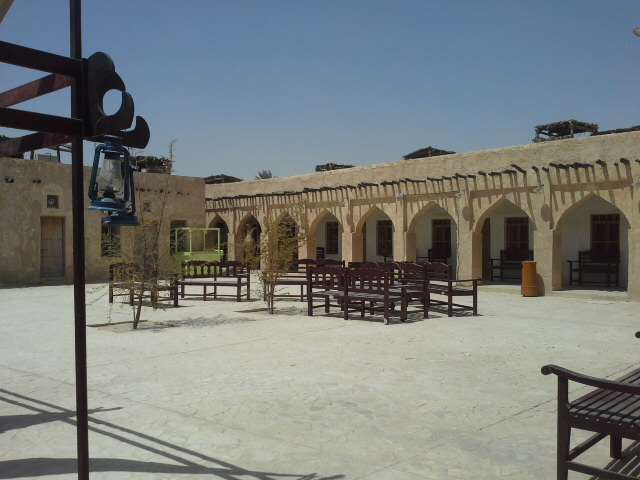 | Figure 2. Al Wakrah Souq. The public spaces for the new entertainment activities designed in the new souq |
3.5. Adaptive Reuse for Architectural Interventions: New Cultural Places
- The growing significance in safeguarding the Qatari heritage has also contributed to the increasing number of restoration projects at the architectural scale, in the last decades. We have compared and analyzed three interventions of adaptive re-use at architectural scale re-used as new cultural places in Qatar. The Heritage Houses restoration project (2006-2015) [17] was about the re-use of four residential buildings, constructed at the beginning of the 20th century: Mohammed Bin Jassim House (1913), Bin Jelmood House (1924), Radwani House and Company House, located in the centre of Doha (Figure 3). The intervention was carried out under the supervision of the Private Engineering Office PEO and the direction of Msheireb Properties Real Estate Company.
 | Figure 3. Mohammed Bin Jassim House |
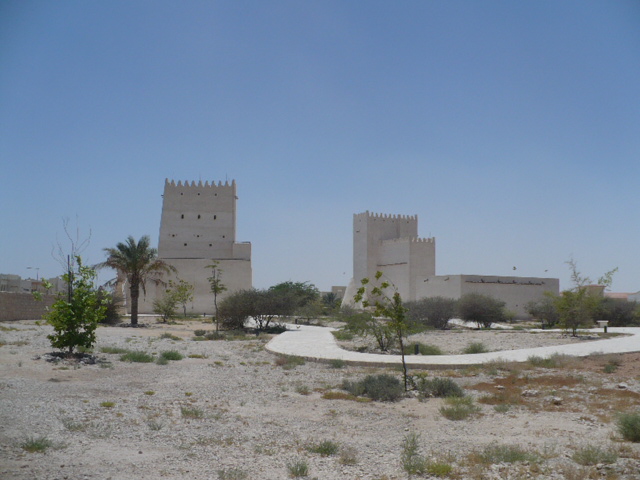 | Figure 4. The Barzan Towers in Doha |
 | Figure 5. Al Dhakhira Mosque, the new cultural and religious center |
3.6. Archaeological Interventions: New Touristic Places
- The most interesting archaeological intervention, re-used as a new touristic place, is al Al Zubarah site (Figure 6) [18]. The conservative project and the campaign of archaeological excavations, completed in 2014 by Qatar Museum Authority (QMA), have promoted the collaboration between the governmental institutions, the local community and the universities of Qatar. Al Zubarah was built up in the 11th century AD during the medieval Islamic period, as a commercial city, then it was destroyed in 1811 and later abandoned in the early 20th century. The Archaeological excavations discovered the remains of the ancient Al Zubarah city including the streets, mosques houses, defensive walls, the harbor, and the palace. During the campaign of archaeological excavations, the bases of the buildings brought to light the traditional techniques and the materials used for construction. Al Zubarah is currently a touristic place, provided with facilities and services for visitors and used as an outdoor urban archaeological museum.
 | Figure 6. Al Zubarah archaeological excavations in the outdoor museum |
4. Results: Sustainable Approaches in the Restoration Field
- Analysis of the restoration works made it possible to compare the methods used, providing an updated description of the adaptive reuse practice in Qatar, which is including the adopted principles and areas of sustainability related to the conducted assessment.The analyzed adaptive reuse projects have often been isolated, and a coordinated plan of all the restoration works, is still missing in Qatar. The analyses were compared in relation to the adaptive reuse, the scale of each project, the type of interventions carried out, the methodology used for upgrading the environmental systems, the materials used, and how the interventions had been completed to enable the buildings and the urban fabric to be brought back into use, showing the different level of contributions in terms of sustainability. The completed works, solutions and strategies were classified into three categories corresponding to the various scales of interventions: urban, architectural and archaeological. The urban category includes conservation and urban regeneration projects, on a large scale. The number of interventions is limited to a few. The architectural category comprises a vast number of conservation projects of small buildings, having different functions and typologies. The archaeological category shows few- unique projects which include both the architectural and the urban scales. The definition of the assessment principles and strategies was based upon the lessons of the heritage re-use and was defined by the revision of the literature focusing on themes of knowledge and sustainability in restoration, to compare approaches, analyses, and observation and of case studies of heritage buildings. The aim was to codify the local building traditions, capable of providing principles and guidelines for the design of the structures to be reused. In the meantime, the research included the interpretation of old materials, techniques, typologies, and the local building culture, exploring the most appropriate solutions and interventions for integrating technological formal and functional proposal of re-use with the sustainable development of the cities.The subject of heritage reuse, widely analyzed in the past for its cultural value, has been always considered from the sustainable point of view, in terms of using of bio-climatic and passive low-cost solutions, which nowadays are quickly assessed and controlled by innovative monitoring systems and dynamic simulations of the energy performance of the heritage building. Most of the past analyzed researches are based on the selection, adoption, and reuse of sustainable building materials (raw earth, stone, wood or bamboo), on the sustainable systems and technological performances, or on the relationship between the building typologies and the thermal hygrometric comfort. However, such approaches, do not consider the social, cultural and economic factors that have determined the development of sustainable, innovative solutions. In this way it was mandatory to adopt a new transversal approach for the codification of the lessons transmitted by heritage buildings, classifying the principles of assessment according to three new areas of interest of sustainability: environmental, socio-economic and socio-cultural. Based on these three areas of interest, the criteria for the definition of the principles of sustainability of heritage buildings and the selection of re-use case studies and strategies, derived from the literature, the research experience and the analysis of the case studies.For each selected intervention the central principles of sustainability were adopted in each area of sustainability to assess the case study. The restoration projects show some specific strategies, and the approach to restoration taken for each intervention was related to the government authorities responsible for the works. The adopted principles of sustainability used for the assessment methodological approach considered also the context in which the project was located, the primary objective of the strategy, the characteristics of the system, its subdivisions and variations in different geographical situations, the contribution in terms of sustainability and the possibilities of re-use the places with new functions. Table 1 and Table 2 document, for each selected case study, the status of the adaptive reuse intervention in Qatar (Table 1) and the adopted assessment systems for the projects (Table 2), describing the features and performance, adopted for environmental, socio-cultural and socio-economic sustainability.The results show that the taken approach for restoration was based on the existing state of deterioration of the buildings and it was more or less preservationist concerning the new use. For example, the adaptive reuse projects have preserved the existing structures only, in particular for the buildings with a new museum function (the Heritage Houses Museums and the Tower Museum) (Table 1). The main aim was to maintain the materials as found, without variation. In other adaptive reuse, notably where massive structural consolidation was carried out due to the advanced level of deterioration, some traditional and innovative materials were combined. In the case of commercial and entertainment re-uses, the restoration projects allowed for typological reproduction, providing the upgraded services as required by the new uses. Regarding the sustainable adopted approach, the results show that the categories of urban and architectural interventions have mainly addressed the principles of sustainability about the socio-cultural and socio-economic areas, while the archaeological interventions have focused primarily in the principles and area of environmental sustainability. As part of the socio-cultural principles of sustainability adopted for the assessment, the quality of labour’s conditions during the interventions have shown that there is a need to improve the general conditions of life and safety during the restoration projects.Besides the assessment form (Table 2) has been used as a questionnaire for a small area survey (Table 3) which was conducted involving various stakeholders ranging from local people, tourists and professionals such as architects and heritage experts. Accordingly, their responses have provided more reliable indicator showing how the selected projects have achieved the assessed principles of sustainability. The results show that in the area of environmental sustainability the selected restoration projects have not achieved the best performances and there is still a need to assess and compare other completed adaptive re-use projects in Qatar.
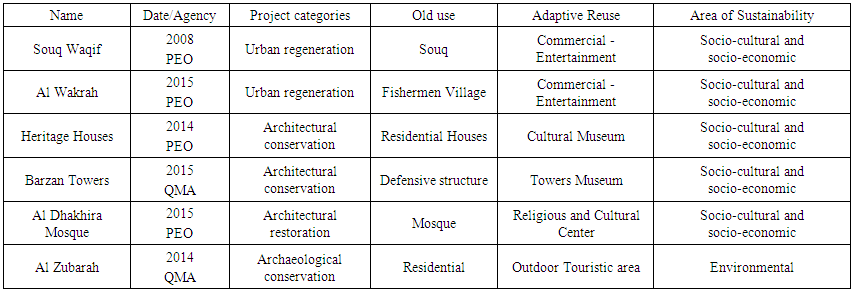 | Table 1. Schematic comparison of adaptive reuse projects completed in Qatar |
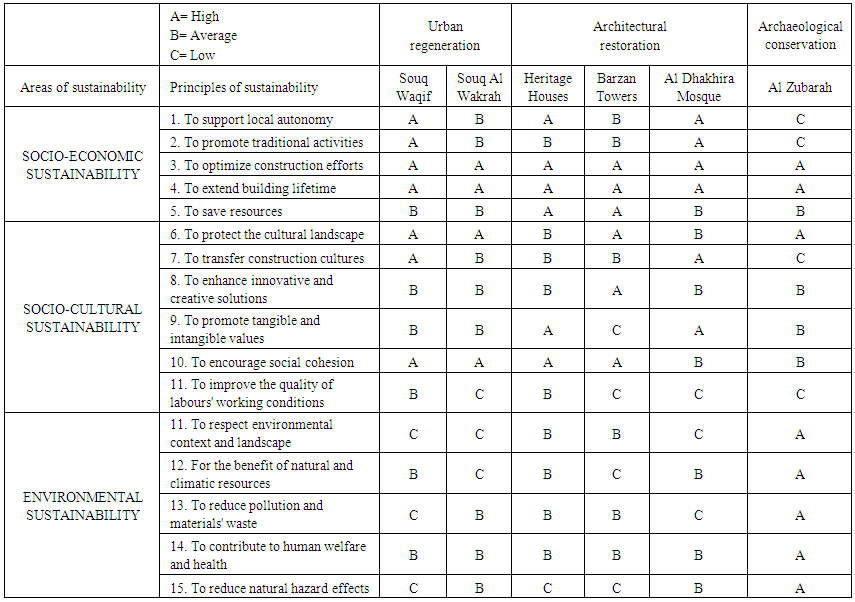 | Table 2. Schematic comparison of areas and principles of sustainability used for assessing the restoration projects completed in Qatar |
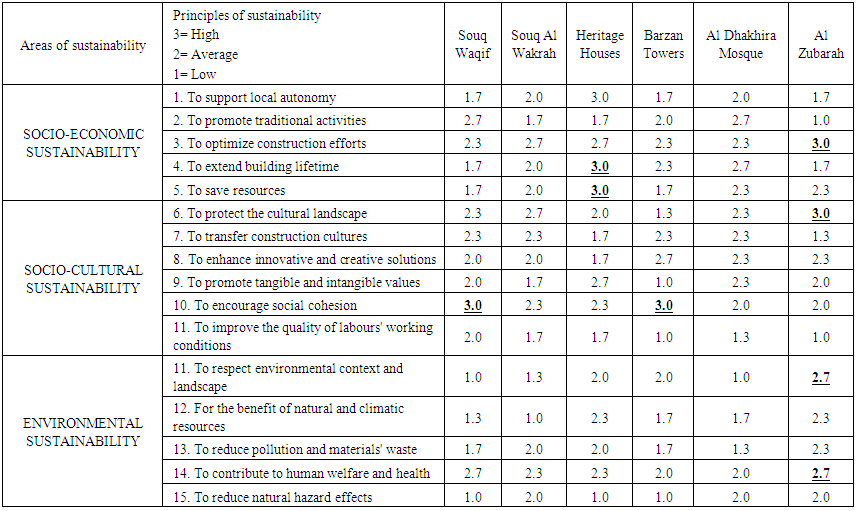 | Table 3. Results of the small area survey, conducted involving various stakeholders |
5. Conclusions
- In Doha, a new emergent global city, despite its fast urbanization and modernization, there is a growing need to safeguard the heritage. In fact, the values of local Qatari tradition and the architectural identity are currently facing the risk to disappear because of the latest massive demolitions. The research presented some significant restoration projects, recently completed in Qatar showing how these adaptive reuse interventions can provide one valid alternative for the growth of the city, respecting and preserving the existing architectural culture and traditions, while addressing the selected principles about the adopted three areas of sustainability. The comparison and description of restoration projects in Qatar show that currently there are various methods for the restoration of architectural, urban and archaeological heritage. The different approaches are imposed by the governmental bodies responsible for the projects. The lessons taught by the Qatari heritage provide innovative answers to some of the social and environmental challenges of the 21st century. Contemporary re-used sustainable architecture should be capable of incorporating proven traditional construction methods and techniques, enhancing them through contemporary means, know-how and technologies. The complete process of reusing heritage buildings can always be changed by modifying the use of sustainable materials or the adopted methods and approaches for interventions. The standards for the sustainable re-use of heritage are available for almost every type of building, and such standards are continually updated and monitored; covering all phases of the building's lifecycle. Heritage buildings designed accordingly to sustainable standards have to monitor in the correct application of the sustainable standards. On the opposite Heritage buildings that were built before the adoption of the sustainability standards have to be upgraded in order to meet the requirements. In particular, the re-used heritage buildings, must be focused on renewable energy and efficiency; the use of environmental friendly building materials and specifications; the efficient use of water; a total reduction of the waste and toxic chemicals produced during the building's construction and operations phases; and a sustainable approach on growth and development. For the sustainable re-use of the heritage, the adopted materials have to satisfy the standards for health and safety. Not only their cost has to be environmentally friendly and competitive, but, if correctly used, these unrefined alternatives have to provide durability and strength for the adopted construction materials. The aim is to reduce the negative impact on the environment by adopting the natural resources more efficiently (e.g., water, energy); protecting the occupants and reducing any adverse impacts on their health and well-being.The principles and indicators of the sustainability of Qatari re-used heritage show the different approaches, strategies, and solutions at the urban, architectural, and archaeological scales, described and assessed according to their degree of sustainability and the critical aspects they present.The research provides a first step in the definition of sustainable and appropriate restoration methods and techniques, design, aimed at planners, architects and local communities, and based upon good experimental, traditional practices with the intention of enhancing the diffusion of Qatari conventional tools and techniques of sustainable construction.
 Abstract
Abstract Reference
Reference Full-Text PDF
Full-Text PDF Full-text HTML
Full-text HTML